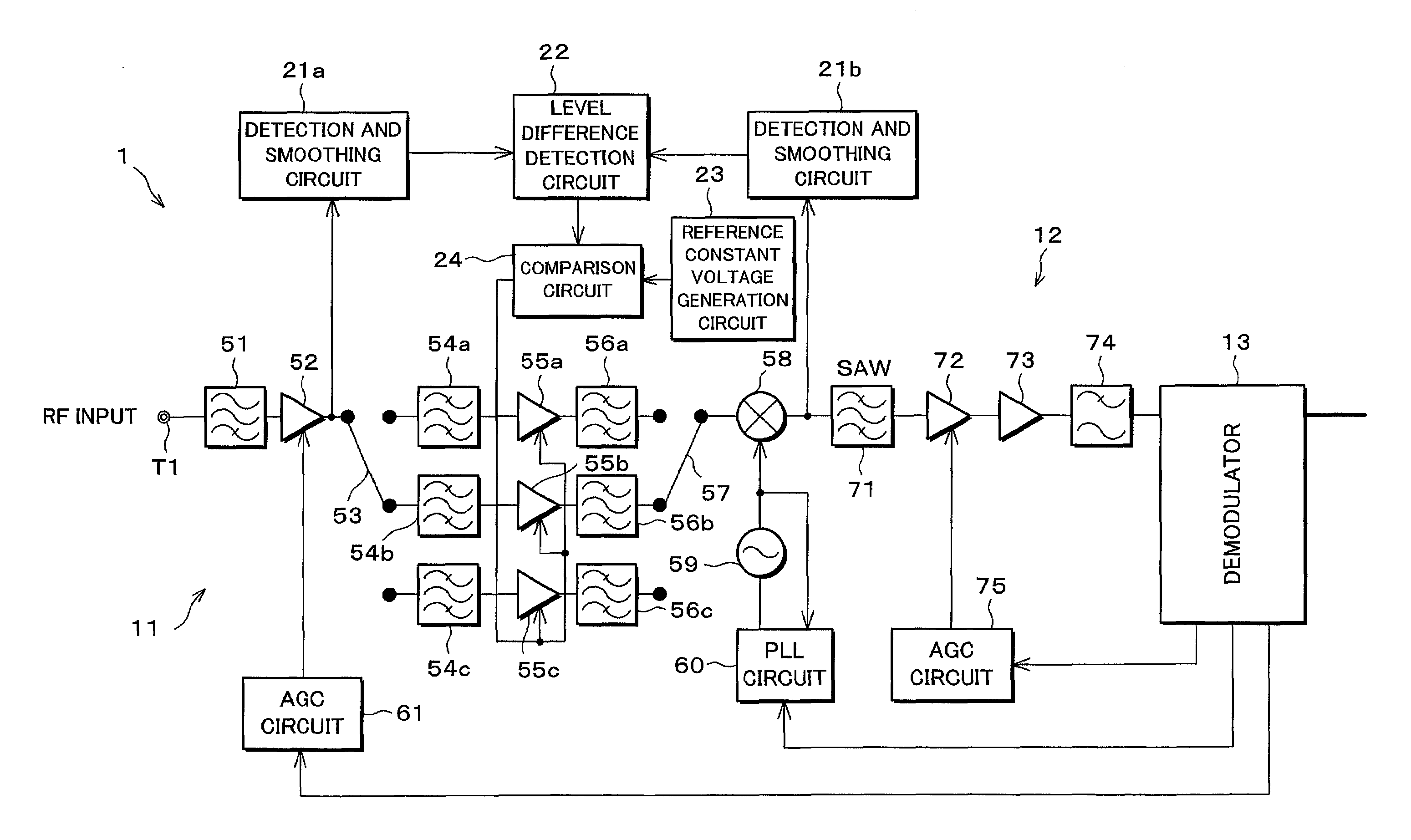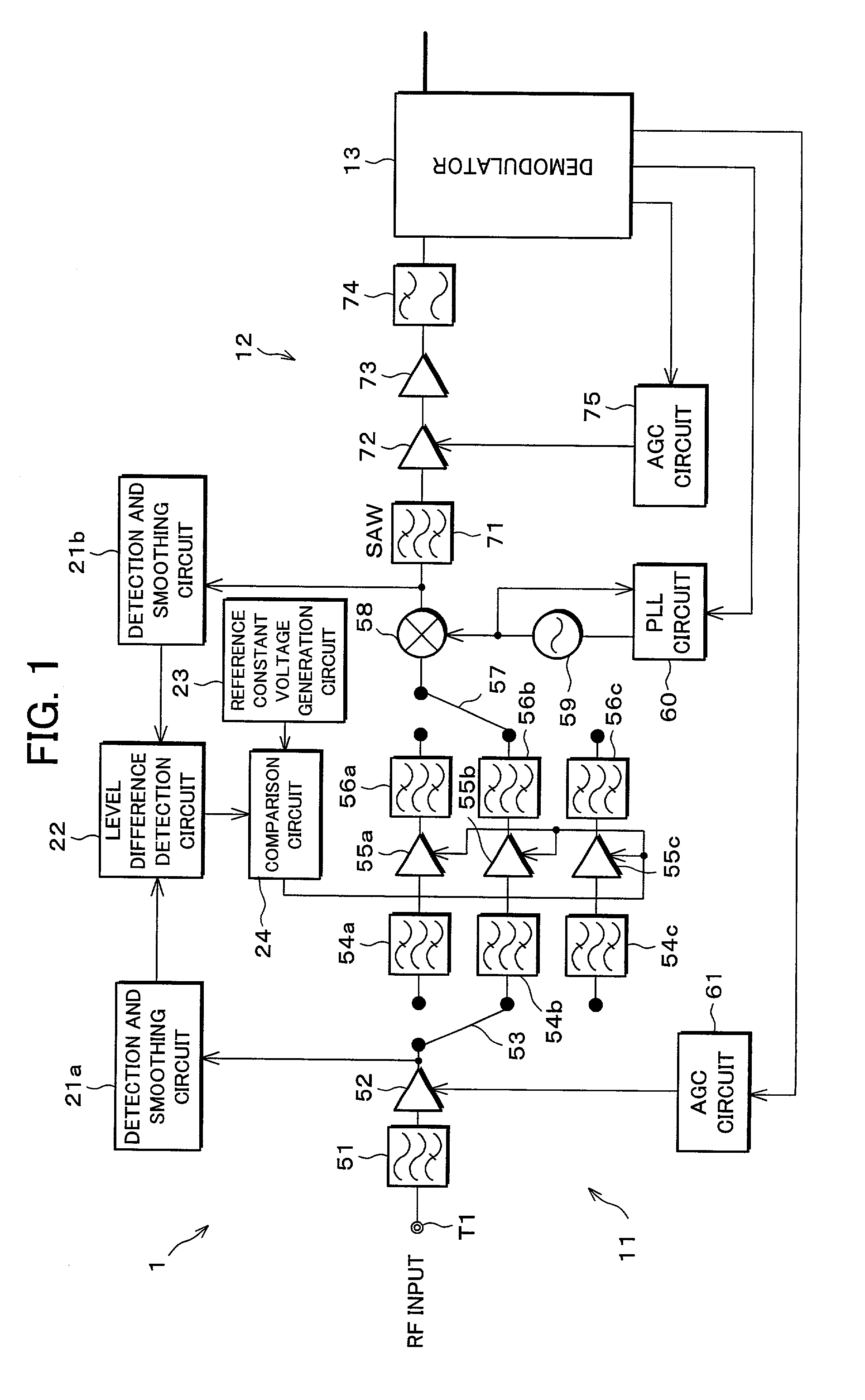Automatic gain control method and automatic gain control circuit
a gain control and automatic gain technology, applied in the direction of gain control, digital transmission, transmission, etc., can solve the problems of low gain deviation range, low receiving sensitivity, and likely waveform distortion, and achieve low waveform distortion and high receiving sensitivity
- Summary
- Abstract
- Description
- Claims
- Application Information
AI Technical Summary
Benefits of technology
Problems solved by technology
Method used
Image
Examples
first embodiment
[First Embodiment]
[0066]Referring to FIGS. 1 through 8, the following description will describe one embodiment of the present invention. That is, an automatic gain control circuit (AGC circuit) in accordance with the present embodiment is a circuit which can obtain a wide dynamic range of an input signal, and is particularly used appropriately in, for example, digital receivers and cable modems for ground wave TV and CATV, etc.
[0067]As one example, explanation will be given on a QAM (Quadrature Amplitude Modulation) receiver for digital CATV. As shown in FIG. 1, a digital receiver (automatic gain control circuit) 1 is structured so as to include a tuner section 11 which selects a signal of a desired channel among a QAM signal (RF input) inputted to an RF input terminal T1, and converts the signal to an intermediate frequency signal having an intermediate frequency, an intermediate frequency processing section 12 for amplifying the intermediate frequency signal, and a demodulator (co...
second embodiment
[Second Embodiment]
[0098]In the first embodiment, explanation has been given on a case where the gain is controlled by the RF-AGC amplifiers 55a to 55c, assuming a structure of a general tuner, that is, a structure in which the RF-AGC amplifiers 55a to 55c whose gains can be adjusted from the outside are already provided in the tuner section 11.
[0099]On the other hand, in a digital receiver 1a in accordance with the present embodiment, as shown in FIG. 9, an IF-AGC amplifier 76 is provided instead of the IF amplifier 73, and the demodulator 13 controls a gain of the IF-AGC amplifier 76. Further, the comparison circuit 24 controls a gain of the IF-AGC amplifier 72 instead of the gains of the RF-AGC amplifiers 55a to 55c. Incidentally, along with these changes, the RF-AGC amplifiers 55a to 55c are changed to RF amplifiers 62a to 62c whose gains are fixed. In this structure, the IF-AGC amplifier 76 corresponds to second gain control means, and the IF-AGC amplifier 72 corresponds to thi...
third embodiment
[Third Embodiment]
[0103]In the present embodiment, explanation will be given on a case where a PIN diode attenuator is used to adjust the gain of the tuner section 11. Incidentally, this structure can be applied either of the foregoing first and second embodiments, but the following explanation will be given on a case where this structure is applied to the first embodiment.
[0104]That is, as shown in FIG. 10, in a digital receiver 1b in accordance with the present embodiment, an RF amplifier 63 and a PIN diode attenuator 64 are provided instead of the RF-AGC amplifier 52 shown in FIG. 1, and the demodulator 13 controls a gain of the PIN diode attenuator (first gain control means) 64 by the AGC circuit 61. Besides, in the present embodiment, dual-gate FETs (Field-Effect Transistors) are used in the RF-AGC amplifiers 55a to 55c for gain control.
[0105]Here, the PIN diode attenuator 64 is a passive element, and is superior in frequency characteristics, compared with a case where gain adj...
PUM
 Login to View More
Login to View More Abstract
Description
Claims
Application Information
 Login to View More
Login to View More - R&D
- Intellectual Property
- Life Sciences
- Materials
- Tech Scout
- Unparalleled Data Quality
- Higher Quality Content
- 60% Fewer Hallucinations
Browse by: Latest US Patents, China's latest patents, Technical Efficacy Thesaurus, Application Domain, Technology Topic, Popular Technical Reports.
© 2025 PatSnap. All rights reserved.Legal|Privacy policy|Modern Slavery Act Transparency Statement|Sitemap|About US| Contact US: help@patsnap.com



